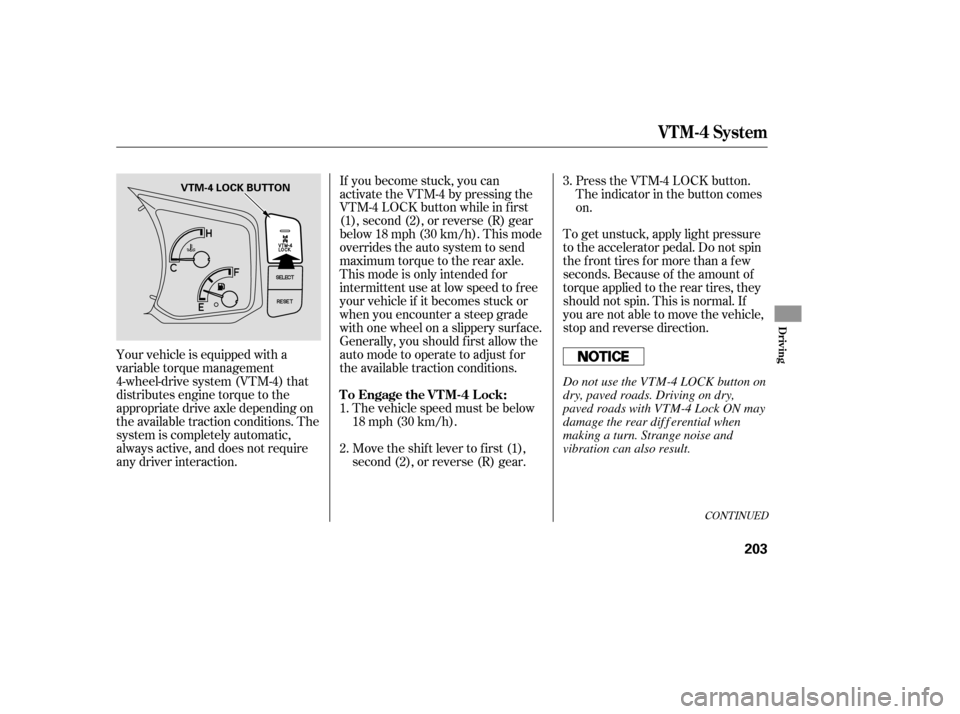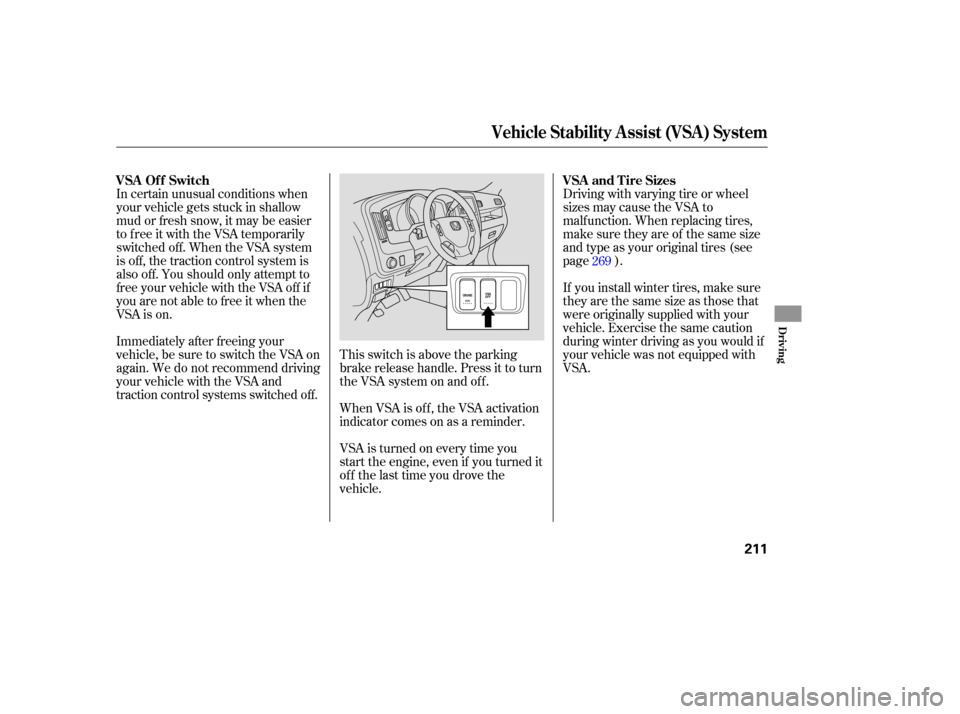2007 HONDA RIDGELINE tires
[x] Cancel search: tiresPage 207 of 331

To get unstuck, apply light pressure
to the accelerator pedal. Do not spin
the f ront tires f or more than a f ew
seconds. Because of the amount of
torque applied to the rear tires, they
should not spin. This is normal. If
you are not able to move the vehicle,
stop and reverse direction.
If you become stuck, you can
activatetheVTM-4bypressingthe
VTM-4 LOCK button while in f irst
(1), second (2), or reverse (R) gear
below18mph(30km/h).Thismode
overrides the auto system to send
maximum torque to the rear axle.
This mode is only intended f or
intermittent use at low speed to free
your vehicle if it becomes stuck or
when you encounter a steep grade
with one wheel on a slippery surf ace.
Generally, you should f irst allow the
auto mode to operate to adjust for
the available traction conditions.
The vehicle speed must be below
18 mph (30 km/h).
Move the shift lever to first (1),
second (2), or reverse (R) gear. Press the VTM-4 LOCK button.
The indicator in the button comes
on.
Your vehicle is equipped with a
variable torque management
4-wheel-drive system (VTM-4) that
distributes engine torque to the
appropriate drive axle depending on
the available traction conditions. The
system is completely automatic,
always active, and does not require
any driver interaction. 1.
2.3.
CONT INUED
To Engage the VTM-4 Lock:
VTM-4 System
Driving
203
VTM-4 LOCK BUTTON
Do not use the VTM-4 LOCK button on
dry, paved roads. Driving on dry,
paved roads with VTM-4 Lock ON may
damage the rear dif f erential when
making a turn. Strange noise and
vibration can also result.
Page 208 of 331

If the tire is f lat, or if the tire
pressure is too low to continue
driving, replace the tire with the
compact spare tire. If you think you can saf ely drive a
short distance to a service station,
proceed slowly, and inf late the tire to
the recommended pressure shown
on the driver’s doorjamb. When this indicator is on, one or
more of your tires is signif icantly
under inf lated. You should stop and
check your tires as soon as possible.
The VTM-4 Lock will temporarily
disengage when the vehicle speed
exceeds 18 mph (30 km/h). The
indicator in the button will remain on.
do
any of the f ollowing: Press the VTM-4 LOCK button. Each tire has its own pressure
sensor. If the air pressure of a tire
becomes signif icantly low, the
sensor in that tire immediately sends
a signal that causes the low tire
pressure indicator and the
appropriate tire on the tire pressure
monitor to come on. Your vehicle is equipped with a tire
pressure monitoring system (TPMS)
that turns on every time you start the
engine and monitors the pressure in
your tires while driving.
Move the shift lever to D.
Turn the ignition switch to the
LOCK (0) position. Low Tire Pressure
Indicator
To Disengage the VTM-4 L ock, Tire Pressure Monitoring System
(T PMS)
VTM-4 System, Tire Pressure Monitoring System (TPMS)
204
Do not continuously spin the f ront tires
of your vehicle. Continuously spinning
the f ront tires can cause transmission
or rear dif f erential damage.
Page 209 of 331

Each wheel is equipped with a tire
pressure sensor mounted inside the
tire behind the valve stem. You must
use TPMS specific wheels. It is
recommended that you always have
your tires serviced by your dealer or
qualified technician.
The
appropriate tire indicator and
low tire pressu re indicator comes on
if a tire becomes significantly
underinflated. See
on page .
Driving
on a signifi cantly under-
inflated tire causes the tire to
ov erheat and can lead to tire failure.
Under-infl ation also reduces fuel
efficiency and tire tread life, and may
affect the vehicle’s handling and
stopping ability.
Al though your tire pressure is
monito red, each tire should be
checked monthly, including the
spare.
Set to the recommended inflation
pressure as specified on the vehicle
placard and in this owner’s manual
(see page ).
Check
the pressure with the tires
cold, after the vehic le has been
parked for at least 3 hours. This
indicator comes on and stays on
if there is a problem with the tire
pressure monitoring system.
If this happens, the system will shut
off and no longer monitor tire
pressures. Have the system checked
by your dealer as soon as possible.
If you have a flat tire, the low tire
pressu re and tire monitor indicators
will come on. Replace the indicated
flat tire with the compact spare tire
(see page ). Never use a puncture-repairing agent
in a f lat tire. If used, you will have to
replace the tire pressure sensor.
Havetheflattirerepairedbyyour
dealer as soon as possible. After you replace the flat tire with
thecompactsparetire,thelowtire
pressure indicator stays on. This is
normal; the system is not monitoring
the spare tire pressure. Manually
check the spare tire pressure to be
sure it is correct.
266 204
275
CONT INUED
Tire Pressure Monitoring
System (T PMS) Indicator Low Tire
Pressure Indicator T ire Pressure Monitor
Changing a T ire with T PMS
Tire Pressure Monitoring System (TPMS)
Driving
205
Page 215 of 331

In certain unusual conditions when
your vehicle gets stuck in shallow
mud or fresh snow, it may be easier
to free it with the VSA temporarily
switched off. When the VSA system
is off, the traction control system is
also off. You should only attempt to Driving
with varying tire or wheel
sizes may cause the VSA to
malfunction. When replacing tires,
make sure they are of the same size
and type as your original tires (see
page ).
If you install winter tires, make sure
they are the same size as those that
were originally supplied with your
vehicle. Exercise the same caution
during winter driving as you would if
your vehicle was not equipped with
VSA.
This switch is above the parking
brake release handle. Press it to turn
the VSA system on and of f .
When VSA is off, the VSA activation
indicator comes on as a reminder.
VSA is turned on every time you
start the engine, even if you turned it
off the last time you drove the
vehicle. 269
Vehicle Stability Assist (VSA) System
VSA Of f Switch
VSA and Tire Sizes
Driving
211
free your vehicle with the VSA off if
you are not able to free it when the
VSA is on.
Immediately after freeing your
vehicle, be sure to switch the VSA on
again. We do not recommend driving
your vehicle with the VSA and
traction control systems switched off.
Page 222 of 331

Always use safety chains when you
tow a trailer. Make sure the chains
are secured to the trailer and hitch,
and that they cross under the tongue
and can catch the trailer if it
becomes unhitched. Leave enough
sl ack to allow the trailer to turn
co rners easily, but do not let the
ch ains drag on the ground.
This device is recommended if your
trailer tends to sway. Your trailer
maker can tell you what kind of sway
control you need and how to install it.
Many states and provinces require
special exterior mirrors when towing
a trailer. Even if they don’t, you
should install special mirrors if you
cannot clearly see behind you, or if
the trailer creates a blind spot. When
towing a trailer, we
recommend that you carry a full-size
spare wheel and tire for your vehicle
and trailer. See page for proper
tire size, page for how to store a
full size wheel and tire, and page
f or inf ormation on changing a
flat tire.
Remember to unhitch the trailer
bef ore changing a f lat. Ask your
trailer sales or rental agency where
and how to store the trailer’s spare
tire. 269
280
275
Saf et y Chains
Sway Cont rolTrailer Mirrors Spare Tires
Towing a Trailer
218
Page 228 of 331

The added weight, length, and
height of a trailer will af f ect your
vehicle’s handling and perf ormance,
so driving with a trailer requires
some special driving skills and
techniques.
Your vehicle tires and spare are in
good condition and properly
inf lated.
The trailer tires and spare are in
good condition and inf lated as
recommended by the trailer
maker.
The vehicle has been properly
serviced, and the tires, brakes,
suspension, cooling system, and
lights are in good operating
condition.
The trailer has been properly
serviced and is in good condition.
All weights and loads are within
limits.
Thehitch,safetychains,andany
other attachments are secure.
Allitemsonandinthetrailerare
properly secured and cannot shif t
while you drive. Towing perf ormance can be
af f ected by high altitude, high
temperature, or when climbing
steep grades. Theref ore, premium
f uel (premium unleaded gasoline
with pump octane number of 91 or
higher) is recommended when
towing more than 3,500 lbs (1,590
kg).
Foryoursafetyandthesafetyof
others,taketimetopracticedriving
maneuvers bef ore heading f or the
open road, and f ollow the guidelines
below.
Avoid towing a trailer during your
vehicle’s f irst 600 miles (1,000 km).
When preparing to tow, and bef ore
driving away, be sure to check the
f ollowing:
Driving Saf ely With a T railer
Pre-T ow Checklist
Towing a Trailer
Break-In Period
224
Page 230 of 331

Always drive slowly and have
someone guide you when backing up.
Grip the of the steering wheel,
then turn the wheel to the left to get
the trailer to move to the left. Turn
the wheel to the right to move the
trailer to the right.
Do not park on an incline unless it is
unavoidable. If you must park on an
incline, follow the steps below to
help prevent the vehicle and trailer
from rolling and possibly injuring
someone. Turn
the front wheels toward the
cu rb on a downhill, and away from
the curb on an uphill.
With the foot brake fully pressed,
have some one place wheel chocks
on the downhill side of the vehicle
and trailer wheels.
Firmly apply the parking brake
before you put the transmission in
Park. This keeps the vehicle from
putting pressure on the parking
mechanism in the transmission. It
also makes it easier to move the
shift lever out of Park when you
want to drive away.
When
parking on level ground,
follow all normal precautions (see
page ) including putting the
transmission in Park, and firmly
setting the parking brake. If
the vehicle’s tires slip when
retr ieving a boat from the water,
shift to first gear, and turn on VTM-4
lock (see page ). Disengage
VTM-4 lock as soon as the boat is
out of the water to prevent damage
to the VTM-4 system.
1.
2.
3.
206 203
bottom
Backing Up
Parking Ret rieving a Boat
Towing a Trailer
226
Page 232 of 331

Before you leave the pavement, be
sure to do all sch eduled maintenance
and service, and inspect your vehic le
for any problems. Pay special
attention to the condition of the tires,
and check the tire pressures.
After you return to the pavement,
carefully inspect your vehicle to
ma ke sure there is no damage that
could make driving it unsafe.
Recheck the condition of the tires
and the tire pressures.
The
route presents limits (too steep
or bumpy road s). You have limits
(driving skill and comfort). And your
vehicle has limits (traction, stability,
and power).
Driving off-highway can be
hazardous if you fail to recognize
limits and take the proper
precau tions.
To
avoid loss of control or rollover,
be sure to follow all precau tions and
recommendations.
Be sure to store cargo properly
and do not exceed your cargo load
limits (see page and ).
Be aware that a heavy load can
reduce ground clearance and your
ability to clear obstacles.
Whenever you drive, make sure
you and your passengers always
wear seat belts.
Keep your speed low, and never
go faster than the conditions allow.
It’s up to you to continually assess
the situation and drive within the
limits. 187 212
Check Out Your Vehicle
Remember
Important Saf ety Precautions
Of f -Highway Driving Guidelines
228